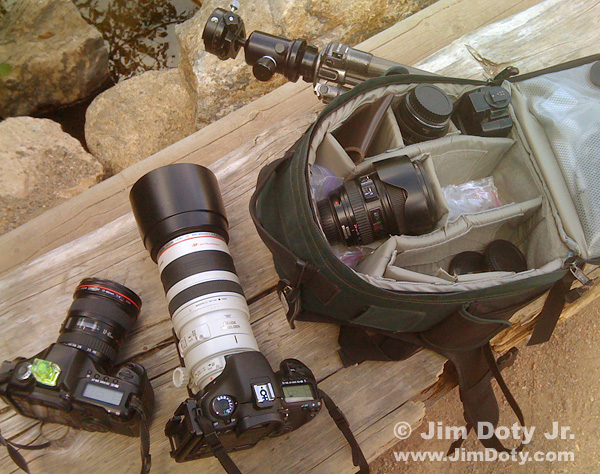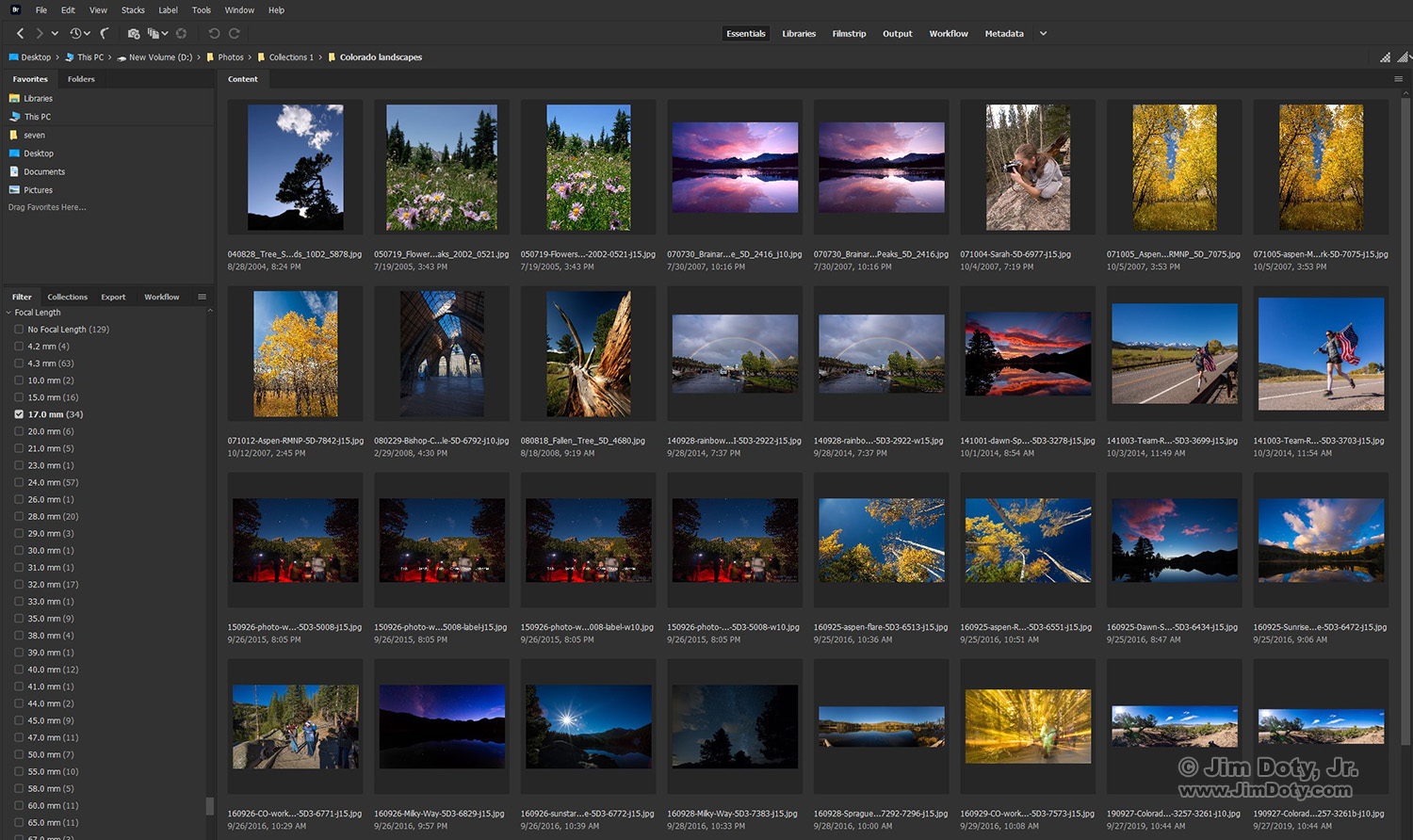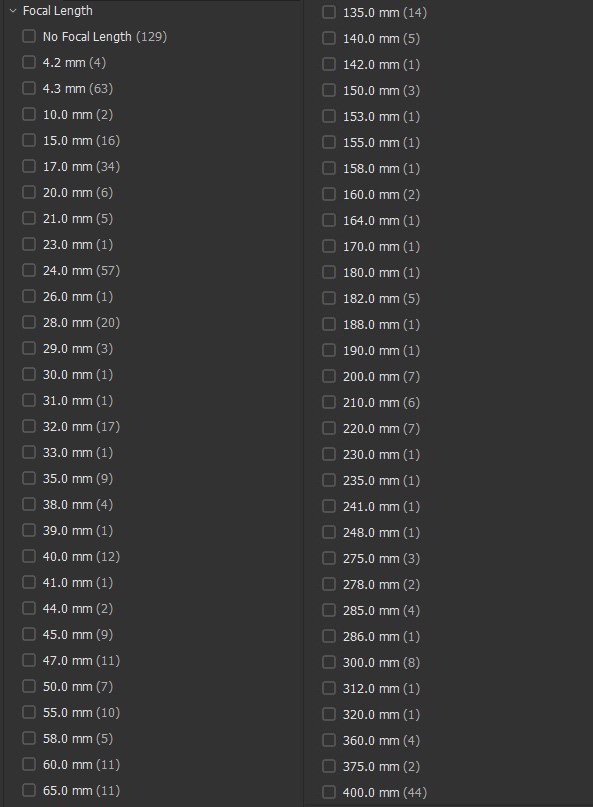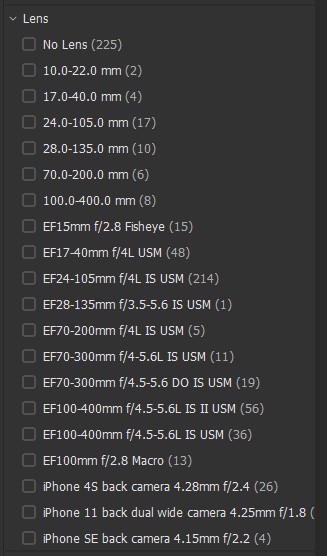A photographer came by recently for some lens purchasing advice. He is headed for Alaska in a couple of months and he has a new R-series Canon camera body. Before his visit I dropped over 700 of my favorite Alaska and Colorado photos into a folder and opened the folder with Adobe Bridge. One of the cool things about Bridge is you can search for photos by the lens that was used, or even individual focal lengths. That way I could show him what was possible with lenses of different focal lengths.
For example, by scrolling through the focal lengths (left side) in Adobe Bridge and putting a check mark in front of 17mm, I could show him all the photos taken at that focal length.
My friend could also get an idea how many photos were taken at each focal length.
Despite Bridge showing 225 photos with no lens, those 225 photos were taken with film cameras (the slides were scanned to create digital images), so no digital information about lenses was attached to those 225 photos.
Here’s the percentage of photos taken with each lens or group of lenses.
15mm semi fisheye: 3%
17-40mm: 12%
24-105mm (and 28-135mm): 54%
Telephoto lenses: 31%
After looking at a bunch of photos at different focal lengths, I gave my friend my standard focal length advice, which I will also pass along to you.
First and most important, you need a standard, all purpose lens that is at least as wide as 24mm. In my experience, the difference between 24mm and 28mm is a big one. That is why I replaced the 28-135mm lens with a 24-105mm lens (and kept the 28-135 as a backup). I told him if he bought a zoom lens that was 28mm to whatever, he would be kicking himself for not getting a zoom lens at least 24mm on the wide end. Since he shoots Canon, I recommended the 24-105mm zoom lens. Over half of my Alaska/Colorado photo were created with a 24-105mm lens.
The second most important lens to have is a telephoto lens. I prefer one that is at least 300mm on the long end, and 400mm would be even better. 21% of my telephoto photos were taken at focal lengths longer than 300mm. Anything shorter than 300mm is just not long enough for my tastes, whether we are talking caribou in Alaska or elk in Colorado. Except for rare occasions, I pretty much retired my 70-200mm lens long ago. If I am packing light I use Canon’s 70-300mm DO (diffractive optics) lens. It is small, relatively light weight, and sharp.
The third most important lens to get, if you have the budget for a third lens, is a wide angle zoom lens. For people shooting Canon, that is the 17-40mm lens.
The fourth and final lens, if you shoot Canon, is the 15mm semi-fisheye lens. It has a 180 degree diagonal angle of view. I don’t use it very much, but in the right situation it creates eye-popping images.
So there you have it. All four lenses are in the photo at the top of this article. I use the 15mm, 17-40mm, and 24-105mm lenses on a camera with a full frame sensor (35mm equivalent). I use the 100-400mm lens on a cropped sensor camera body. For the difference, see the Digital Field of View Crop article linked below.
Photo gear for a trip to Rocky Mountain National Park. A. Canon 5D and EF 17-40mm f/4L lens. B. Canon 7D and EF 100-400mm L lens. C. Canon EF 24-105mm f/4L lens. D. Canon EF 15mm fisheye lens. E. Canon 550 EX flash. F. Kirk Enterprises BH-3 ball head and Gitzo Mountaineer G1228 MK2 tripod.
Lenses come in different price ranges. Buy lenses you can afford.
The Canon f/4 24-105mm L series lens is pricey at around $1300, but the Canon f/2.8 24-70mm L series lens costs around $1,900. Most people don’t need an f/2.8 lens so why pay 600 more? On the other hand you can get a used Canon f/3.5-5.6 28-135mm lens for about $160. True, it doesn’t have the 24mm focal length I prefer, but sometimes the price is the more important consideration.
Some of the EF-S lenses for cropped sensor camera bodies cost even less. If you are looking for light weight, less expensive Canon camera gear, check out the first linked article below. The three Canon lenses in my light weight kit are 10-18mm, 18-55mm, and 55-250mm.
The online camera stores I trust are B&H photo and Adorama, both in New York City. I also trust KEH in Atlanta for used photo gear.
Links
Can a $239 Lens Do the Job of a $2100 Lens?
Field of View Crop in Digital SLRs





